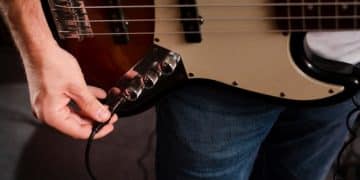Power Metal Vocal Techniques: High Notes and Belting Guide

Power metal vocal techniques encompass a range of methods to achieve high notes, sustain belting, and deliver powerful performances, requiring diligent practice and a solid understanding of vocal mechanics.
Power metal is renowned for its soaring vocals and impressive high notes. Mastering Power Metal Vocal Techniques: Achieving High Notes and Sustained Belting is essential for singers aspiring to conquer this genre. This article will delve into the techniques needed to achieve those stratospheric sounds.
Understanding Power Metal Vocal Styles
Power metal vocal styles are characterized by their soaring high notes, sustained belting, and overall theatrical delivery. Understanding the core elements of these styles is crucial for any aspiring power metal vocalist. Let’s explore the characteristics that define power metal vocals.
Power metal vocalists often draw inspiration from opera, classical music, and traditional heavy metal. This blend of influences contributes to the unique and captivating sound that defines the genre.
Key Vocal Characteristics
Several key characteristics define the power metal vocal style, each requiring specific techniques and practice. Identifying and mastering these elements is essential for achieving that powerful and dynamic sound.
- High Range: Power metal vocalists frequently reach for and sustain high notes, often pushing the limits of their vocal range.
- Belting: Sustained belting is a common feature, allowing singers to hold powerful notes for extended periods.
- Clarity and Precision: Despite the high energy and intensity, clear enunciation and precise control are crucial.
- Theatrical Delivery: Many power metal singers adopt a theatrical or operatic style, adding drama and emotion to their performances.
Understanding these vocal characteristics is the first step toward mastering the techniques required to perform power metal vocals effectively. Practice and dedication are key to developing the necessary skills.
Vocal Warm-Up Exercises for Power Metal Singers
Before attempting any demanding vocal techniques, warming up the vocal cords is essential to prevent injury and improve performance. Vocal warm-ups should be a staple routine for all power metal singers. Here are some effective exercises to get you started.
These exercises are designed to gradually prepare your vocal muscles and increase your vocal range. Consistency and proper technique are key.

Essential Warm-Up Techniques
A comprehensive warm-up should include exercises that address breath control, vocal cord flexibility, and resonance. These techniques will help prepare your voice for the demands of power metal vocals.
- Lip Trills: Help relax the vocal cords and improve breath control.
- Humming: Warms up the voice and promotes resonance.
- Scales: Gradually increase vocal range and improve pitch accuracy.
- Sirens: Gliding from low to high notes to increase vocal flexibility.
Regularly performing these exercises ensures that your vocal cords are prepared for the rigors of power metal singing. Remember to listen to your body and avoid pushing yourself too hard, especially during warm-ups.
Breathing Techniques for Sustained Belting
Proper breathing techniques are fundamental for achieving sustained belting, a hallmark of power metal vocals. Effective breath control can provide the necessary support and stamina. Let’s explore the techniques that can help you sustain those powerful notes.
Diaphragmatic breathing, also known as belly breathing, is the foundation for sustained vocal performance. This technique allows for greater control and efficiency. Practicing regularly will help you develop the necessary muscle memory and coordination.
Diaphragmatic Breathing
Diaphragmatic breathing involves engaging the diaphragm to control airflow, providing consistent support for your vocal cords. Mastering this technique is crucial for singers aiming for sustained belting.
To practice diaphragmatic breathing, place one hand on your chest and the other on your abdomen. Breathe in deeply, focusing on expanding your abdomen while keeping your chest relatively still. As you exhale, control the release of air to maintain a steady flow. This technique will help you develop the muscle memory and coordination needed for powerful and sustained vocal performance.
By mastering these breathing techniques, you’ll be well-equipped to tackle the demanding vocal requirements of power metal. Remember that consistent practice is the key to developing the necessary muscle memory and control.
Resonance and Vocal Placement for High Notes
Achieving high notes in power metal requires understanding and utilizing resonance and vocal placement. Manipulating these elements can help you produce clear and powerful high notes without straining your voice. Resonance involves amplifying the sound within your vocal tract.
Vocal placement involves consciously directing your voice towards different areas of your vocal tract to modify its tone. Mastering both aspects can significantly improve the quality of your high notes.

Understanding Vocal Resonance
Resonance occurs when sound vibrations are amplified within the vocal tract, creating a richer and fuller tone. Different resonance points can be utilized to achieve various vocal qualities.
Your body has a natural resonance. The control over vocal placement can dramatically affect your sound.
- Chest Resonance: Produces a warm and powerful tone, often used for lower notes.
- Mouth Resonance: Creates a bright and clear sound, ideal for mid-range notes.
- Nasal Resonance: Adds a ringing quality to high notes, making them more vibrant and resonant.
Experiment with different resonance points to find what works best for your voice. Practice consciously directing your voice towards these areas to improve the quality and projection of your high notes.
Vocal Health and Maintenance for Singers
Maintaining vocal health is crucial for any singer, especially those tackling the demanding techniques of power metal. Protecting your vocal cords and adopting healthy habits can prevent injuries and ensure a long-lasting career. Hydration, rest, and avoiding harmful substances are the keystones of vocal health.
Consistent practice and responsible vocal care go hand in hand. Ignoring vocal health can lead to strain, hoarseness, and even long-term damage.
Key Vocal Health Practices
Adopting these practices can significantly improve your vocal health and prevent common singing-related issues. Incorporate these tips into your daily routine for optimal vocal performance.
- Stay Hydrated: Drink plenty of water to keep your vocal cords lubricated.
- Rest Your Voice: Avoid excessive talking or singing when your voice feels tired.
- Avoid Irritants: Limit exposure to smoke, allergens, and other irritants that can inflame the vocal cords.
- Warm-Up and Cool-Down: Always warm up before singing and cool down afterward to prevent strain.
By prioritizing vocal health, you can ensure a long and fulfilling career as a power metal vocalist. Regular check-ups with a vocal coach or ENT specialist can also help identify and address potential issues early on.
Advanced Techniques: Vocal Agility and Runs
Once you have mastered the basics, you can begin exploring advanced techniques such as vocal agility and runs. These techniques add complexity and flair to your performances. Vocal agility refers to the ability to move quickly and smoothly between notes.
It involves a combination of breath control, vocal cord coordination, and practice. Vocal runs are a series of quick notes, often used to embellish melodies and demonstrate vocal prowess.
Developing Vocal Agility
Vocal agility requires precise control and coordination. These exercises will help you develop the necessary skills to navigate complex melodies and execute impressive vocal runs.
Start with scales and arpeggios to improve your overall vocal control and coordination. Practice gradually increasing the speed to build agility. Use vocal exercises such as “the tongue trill” to practice control and agility.
- Scales and Arpeggios: Improve overall vocal control and coordination.
- Chromatic Exercises: Enhance your ability to move smoothly between notes.
- Tongue Twisters: Improve enunciation and articulation for faster passages.
With consistent practice, you can develop the vocal agility needed to tackle the intricate melodies and impressive runs that characterize power metal vocals. Remember to focus on precision and clarity, even at faster tempos.
| Key Point | Brief Description |
|---|---|
| 🎤 Warm-Up Exercises | Essential for preparing vocal cords and preventing injury. |
| 🫁 Breathing Techniques | Diaphragmatic breathing is crucial for sustained belting. |
| 🎶 Vocal Placement & Resonance | Utilizing resonance points enhances high notes. |
| 🛡️ Vocal Health | Proper care can prevent injuries and ensure longevity. |
Frequently Asked Questions
▼
Lip trills are crucial. They relax the vocal cords and improve breath control, essential for handling the demands of power metal.
▼
Consistent practice with scales and sirens can gradually expand your vocal range. Be patient and avoid straining to protect your voice.
▼
Good posture supports proper breathing and vocal technique. Stand tall with relaxed shoulders to allow for optimal lung capacity and vocal cord function.
▼
Regular, shorter sessions are more effective than sporadic, long practices. Aim for at least 30 minutes a day, focusing on proper technique and vocal health.
▼
Rest your voice immediately. Avoid talking or singing until your voice recovers. Hydrate and consider using a humidifier to soothe your vocal cords.
Conclusion
Mastering power metal vocal techniques requires dedication, consistent practice, and a deep understanding of vocal mechanics. By focusing on breathing techniques, resonance, vocal health, and advanced skills, you can unlock your potential and achieve those soaring high notes and sustained belting that define the genre.





